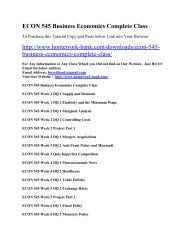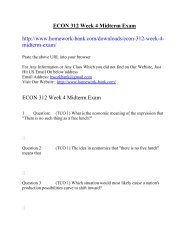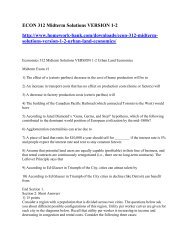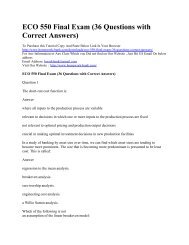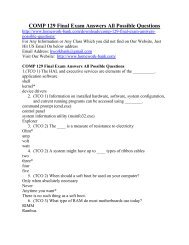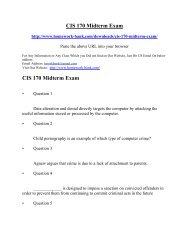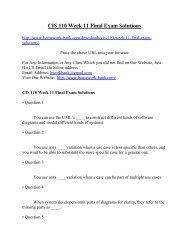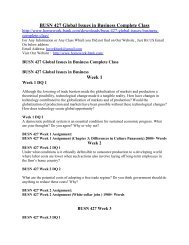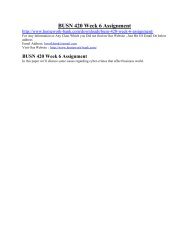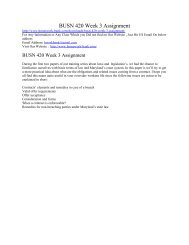o_19i2p1huq16a314d811npceahlh1p.pdf
For Any Information or Any Class Which you Did not find on Our Website , Just Hit US Email On below address Email Address: hworkbank@gmail.com Visit Our Website : http://www.homework-bank.com/
For Any Information or Any Class Which you Did not find on Our Website , Just Hit US Email On below address
Email Address: hworkbank@gmail.com
Visit Our Website : http://www.homework-bank.com/
You also want an ePaper? Increase the reach of your titles
YUMPU automatically turns print PDFs into web optimized ePapers that Google loves.
ACC 422 Week 5 Final Exam<br />
http://www.homework-bank.com/downloads/acc-422-week-<br />
5-final-exam/<br />
Paste the above URL into your browser<br />
For Any Information or Any Class Which you Did not find on Our Website , Just Hit US Email On below<br />
address<br />
Email Address: hworkbank@gmail.com<br />
Visit Our Website : http://www.homework-bank.com/<br />
ACC 422 Week 5 Final Exam<br />
1) Which of the following is NOT considered cash for financial reporting purposes?<br />
A. Postdated checks and I.O.U.'s<br />
B. Money orders, certified checks, and personal checks<br />
C. Petty cash funds and change funds<br />
D. Coin, currency, and available funds<br />
2) What is the preferable presentation of accounts receivable from officers, employees, or affiliated<br />
companies on a balance sheet?<br />
A. As assets but separately from other receivables.<br />
B. As offsets to capital.<br />
C. As trade notes and accounts receivable if they otherwise qualify as current assets.<br />
D. By means of footnotes only.<br />
3) Which of the following items should NOT be included in the Cash caption on the balance sheet?<br />
A. Amounts on deposit in checking account at the bank<br />
B. Coins and currency in the cash register<br />
C. Postage stamps on hand<br />
D. Checks from other parties presently in the cash register<br />
4) The advantage of relating a company's bad debt expense to its outstanding accounts receivable is<br />
that this approach<br />
A. is the only generally accepted method for valuing accounts receivable.<br />
B. gives a reasonably correct statement of receivables in the balance sheet.<br />
C. makes estimates of uncollectible accounts unnecessary.<br />
D. best relates bad debt expense to the period of sale.<br />
5) Which of the following is a generally accepted method of determining the amount of the<br />
adjustment to bad debt expense?<br />
A. A percentage of accounts receivable NOT adjusted for the balance in the allowance<br />
B. A percentage of sales adjusted for the balance in the allowance<br />
C. An amount derived from aging accounts receivable and NOT adjusted for the balance in<br />
the allowance
D. A percentage of sales NOT adjusted for the balance in the allowance<br />
6) Assuming that the ideal measure of short-term receivables in the balance sheet is the discounted<br />
value of the cash to be received in the future, failure to follow this practice usually does NOT make<br />
the balance sheet misleading because<br />
A. the amount of the discount is NOT material.<br />
B. most short-term receivables are NOT interest-bearing.<br />
C. most receivables can be sold to a bank or factor.<br />
D. the allowance for uncollectible accounts includes a discount element.<br />
7) Eller Co. received merchandise on consignment. As of January 31, Eller included the goods in<br />
inventory, but did NOT record the transaction. The effect of this on its financial statements for<br />
January 31 would be<br />
A. net income and current assets were overstated and current liabilities were understated.<br />
B. net income, current assets, and retained earnings were overstated.<br />
C. net income, current assets, and retained earnings were understated.<br />
D. net income was correct and current assets were understated.<br />
8) If the beginning inventory for 2006 is overstated, the effects of this error on cost of goods sold for<br />
2006, net income for 2006, and assets at December 31, 2007, respectively, are<br />
A. understatement, overstatement, overstatement.<br />
B. overstatement, understatement, overstatement.<br />
C. understatement, overstatement, no effect.<br />
D. overstatement, understatement, no effect.<br />
9) The accountant for the Orion Sales Company is preparing the income statement for 2007 and the<br />
balance sheet at December 31, 2007. Orion uses the periodic inventory system. The January 1, 2007<br />
merchandise inventory balance will appear<br />
A. as a deduction in the cost of goods sold section of the income statement and as a current<br />
asset on the balance sheet.<br />
B. only as an asset on the balance sheet.<br />
C. as an addition in the cost of goods sold section of the income statement and as a current<br />
asset on the balance sheet.<br />
D. only in the cost of goods sold section of the income statement.<br />
10) The use of a Discounts Lost account implies that the recorded cost of a purchased inventory<br />
item is its<br />
A. invoice price less the purchase discount taken.<br />
B. invoice price less the purchase discount allowable whether taken or not.<br />
C. invoice price plus the purchase discount lost.<br />
D. invoice price.<br />
11) When using the periodic inventory system, which of the following generally would NOT be<br />
separately accounted for in the computation of cost of goods sold?
A. Purchase returns and allowances of merchandise during the period<br />
B. Cost of transportation-in for merchandise purchased during the period<br />
C. Cash (purchase) discounts taken during the period<br />
D. Trade discounts applicable to purchases during the period<br />
12) The use of a Purchase Discounts account implies that the recorded cost of a purchased<br />
inventory item is its<br />
A. invoice price less the purchase discount taken.<br />
B. invoice price less the purchase discount allowable whether taken or not.<br />
C. invoice price plus any purchase discount lost.<br />
D. invoice price.<br />
13) In no case can "market" in the lower-of-cost-or-market rule be more than<br />
A. estimated selling price in the ordinary course of business less reasonably predictable<br />
costs of completion and disposal and an allowance for an approximately normal profit margin.<br />
B. estimated selling price in the ordinary course of business less reasonably predictable<br />
costs of completion and disposal, an allowance for an approximately normal profit margin, and an<br />
adequate reserve for possible future losses.<br />
C. estimated selling price in the ordinary course of business less reasonably predictable<br />
costs of completion and disposal.<br />
D. estimated selling price in the ordinary course of business.<br />
14) When the direct method is used to record inventory at market<br />
A. only the portion of the loss attributable to inventory sold during the period is recorded<br />
in the financial statements.<br />
B. the market value figure for ending inventory is substituted for cost and the loss is buried<br />
in cost of goods sold<br />
C. a loss is recorded directly in the inventory account by crediting inventory and debiting<br />
loss on inventory decline.<br />
D. there is a direct reduction in the selling price of the product that results in a loss being<br />
recorded on the income statement prior to the sale.<br />
15) Designated market value<br />
A. may sometimes exceed net realizable value.<br />
B. should always be equal to net realizable value less a normal profit margin.<br />
C. should always be equal to net realizable value.<br />
D. is always the middle value of replacement cost, net realizable value, and net realizable<br />
value less a normal profit margin.<br />
16) The retail inventory method is based on the assumption that the
A. ratio of cost to retail changes at a constant rate.<br />
B. proportions of markups and markdowns to selling price are the same.<br />
C. ratio of gross margin to sales is approximately the same each period.<br />
D. final inventory and the total of goods available for sale contain the same proportion of<br />
high-cost and low-cost ratio goods.<br />
17) In 2006, Lucas Manufacturing signed a contract with a supplier to purchase raw materials in<br />
2007 for $700,000. Before the December 31, 2006 balance sheet date, the market price for these<br />
materials dropped to $510,000. The journal entry to record this situation at December 31, 2006 will<br />
result in a credit that should be reported<br />
A. as an appropriation of retained earnings.<br />
B. on the income statement.<br />
C. as a current liability.<br />
D. as a valuation account to Inventory on the balance sheet.<br />
18) The gross profit method of inventory valuation is invalid when<br />
A. there is no beginning inventory because it is the first year of operation.<br />
B. there is a substantial increase in inventory during the year.<br />
C. none of these.<br />
D. a portion of the inventory is destroyed.<br />
19) Which of the following is NOT a major characteristic of a plant asset?<br />
A. Acquired for use<br />
B. Acquired for resale<br />
C. Yields services over a number of years<br />
D. Possesses physical substance<br />
20) The cost of land does NOT include<br />
A. costs of improvements with limited lives.<br />
B. costs of removing old buildings.<br />
C. special assessments.<br />
D. costs of grading, filling, draining, and clearing.<br />
21) If a corporation purchases a lot and building and subsequently tears down the building and<br />
uses the property as a parking lot, the proper accounting treatment of the cost of the building<br />
would depend on<br />
A. the contemplated future use of the parking lot.<br />
B. the length of time for which the building was held prior to its demolition.<br />
C. the intention of management for the property when the building was acquired.
D. the significance of the cost allocated to the building in relation to the combined cost of<br />
the lot and building.<br />
22) To be consistent with the historical cost principle, overhead costs incurred by an enterprise<br />
constructing its own building should be<br />
A. allocated on an opportunity cost basis.<br />
B. eliminated completely from the cost of the asset.<br />
C. allocated on a pro rata basis between the asset and normal operations.<br />
D. allocated on the basis of lost production.<br />
23) When computing the amount of interest cost to be capitalized, the concept of "avoidable<br />
interest" refers to<br />
A. that portion of total interest cost which would NOT have been incurred if expenditures<br />
for asset construction had NOT been made.<br />
B. a cost of capital charge for stockholders' equity.<br />
C. that portion of average accumulated expenditures on which no interest cost was<br />
incurred.<br />
D. the total interest cost actually incurred.<br />
24) The period of time during which interest must be capitalized ends when<br />
A. the asset is abandoned, sold, or fully depreciated.<br />
B. no further interest cost is being incurred.<br />
C. the activities that are necessary to get the asset ready for its intended use have begun.<br />
D. the asset is substantially complete and ready for its intended use.<br />
25) Construction of a qualifying asset is started on April 1 and finished on December 1. The<br />
fraction used to multiply an expenditure made on April 1 to find weighted-average accumulated<br />
expenditures is<br />
A. 9/12.<br />
B. 8/12.<br />
C. 11/12.<br />
D. 8/8.<br />
26) When funds are borrowed to pay for construction of assets that qualify for capitalization of<br />
interest, the excess funds NOT needed to pay for construction may be temporarily invested in<br />
interest-bearing securities. Interest earned on these temporary investments should be<br />
A. multiplied by an appropriate interest rate to determine the amount of interest to be<br />
capitalized.<br />
B. offset against interest cost incurred during construction.<br />
C. used to reduce the cost of assets being constructed.<br />
D. recognized as revenue of the period.
27) When a plant asset is acquired by issuance of common stock, the cost of the plant asset is<br />
properly measured by the<br />
A. book value of the stock.<br />
B. par value of the stock.<br />
C. stated value of the stock.<br />
D. market value of the stock.<br />
28) If an industrial firm uses the units-of-production method for computing depreciation on its only<br />
plant asset, factory machinery, the credit to accumulated depreciation from period to period during<br />
the life of the firm will<br />
A. vary with sales revenue.<br />
B. be constant.<br />
C. vary with unit sales.<br />
D. vary with production.<br />
29) The term "depreciable cost," or "depreciable base," as it is used in accounting, refers to<br />
A. the estimated market value of the asset at the end of its useful life.<br />
B. the total amount to be charged (debited) to expense over an asset's useful life.<br />
C. the cost of the asset less the related depreciation recorded to date.<br />
D. the acquisition cost of the asset.<br />
30) Which of the following most accurately reflects the concept of depreciation as used in<br />
accounting?<br />
A. A method of allocating asset cost to an expense account in a manner which closely<br />
matches the physical deterioration of the tangible asset involved.<br />
B. The process of charging the decline in value of an economic resource to income in the<br />
period in which the benefit occurred.<br />
C. The process of allocating the cost of tangible assets to expense in a systematic and<br />
rational manner to those periods expected to benefit from the use of the asset.<br />
D. An accounting concept that allocates the portion of an asset used up during the year to<br />
the contra asset account for the purpose of properly recording the fair market value of tangible<br />
assets.<br />
31) Prentice Company purchased a depreciable asset for $200,000. The estimated salvage value is<br />
$20,000, and the estimated useful life is 10 years. The straight-line method will be used for<br />
depreciation. What is the depreciation base of this asset?<br />
A. $180,000<br />
B. $18,000<br />
C. $20,000
D. $200,000<br />
32) Pine Company purchased a depreciable asset for $360,000. The estimated salvage value is<br />
$24,000, and the estimated useful life is 8 years. The double-declining balance method will be used<br />
for depreciation. What is the depreciation expense for the second year on this asset?<br />
A. $67,500<br />
B. $42,000<br />
C. $63,000<br />
D. $90,000<br />
33) Bigbie Company purchased a depreciable asset for $600,000. The estimated salvage value is<br />
$30,000, and the estimated useful life is 10,000 hours. Bigbie used the asset for 1,100 hours in the<br />
current year. The activity method will be used for depreciation. What is the depreciation expense<br />
on this asset?<br />
A. $66,000<br />
B. $57,000<br />
C. $62,700<br />
D. $570,000<br />
34) The cost of purchasing patent rights for a product that might otherwise have seriously<br />
competed with one of the purchaser's patented products should be<br />
A. added to factory overhead and allocated to production of the purchaser's product.<br />
B. amortized over the remaining estimated life of the original patent covering the product<br />
whose market would have been impaired by competition from the newly patented product.<br />
C. charged off in the current period.<br />
D. amortized over the legal life of the purchased patent.<br />
35) Riser Corporation was granted a patent on a product on January 1, 1998. To protect its patent,<br />
the corporation purchased on January 1, 2007 a patent on a competing product which was<br />
originally issued on January 10, 2003. Because of its unique plant, Riser Corporation does NOT feel<br />
the competing patent can be used in producing a product. The cost of the competing patent should<br />
be<br />
A. amortized over a maximum period of 11 years.<br />
B. expensed in 2007.<br />
C. amortized over a maximum period of 20 years.<br />
D. amortized over a maximum period of 16 years.<br />
36) Which of the following methods of amortization is normally used for intangible assets?<br />
A. Units of production<br />
B. Double-declining-balance<br />
C. Sum-of-the-years'-digits<br />
D. Straight-line
37) General Products Company bought Special Products Division in 2006 and appropriately<br />
booked $250,000 of goodwill related to the purchase. On December 31, 2007, the fair value of<br />
Special Products Division is $2,000,000 and it is carried on General Product’s books for a total of<br />
$1,700,000, including the goodwill. An analysis of Special Products Division’s assets indicates that<br />
goodwill of $200,000 exists on December 31, 2007. What goodwill impairment should be recognized<br />
by General Products in 2007?<br />
A. $50,000.<br />
B. $300,000.<br />
C. $0.<br />
D. $200,000.<br />
38) Twilight Corporation acquired End-of-the-World Products on January 1, 2008 for $2,000,000,<br />
and recorded goodwill of $375,000 as a result of that purchase. At December 31, 2008, the End-ofthe-World<br />
Products Division had a fair value of $1,700,000. The net identifiable assets of the<br />
Division (excluding goodwill) had a fair value of $1,450,000 at that time. What amount of loss on<br />
impairment of goodwill should Twilight record in 2008?<br />
A. $175,000<br />
B. $300,000<br />
C. $ -0-<br />
D. $125,000<br />
39) Fleming Corporation acquired Out-of-Sight Products on January 1, 2008 for $4,000,000, and<br />
recorded goodwill of $750,000 as a result of that purchase. At December 31, 2008, the Out-of-Sight<br />
Products Division had a fair value of $3,400,000. The net identifiable assets of the Division<br />
(excluding goodwill) had a fair value of $2,900,000 at that time. What amount of loss on impairment<br />
of goodwill should Fleming record in 2008?<br />
A. $350,000<br />
B. $600,000<br />
C. $ -0-<br />
D. $250,000<br />
40) When a patent is amortized, the credit is usually made to<br />
A. a Deferred Credit account.<br />
B. an expense account.<br />
C. the Patent account.<br />
D. an Accumulated Amortization account.<br />
41) The reason goodwill is sometimes referred to as a master valuation account is because<br />
A. the value of a business is computed without consideration of goodwill and then goodwill<br />
is added to arrive at a master valuation.<br />
B. it is the only account in the financial statements that is based on value, all other accounts<br />
are recorded at an amount other than their value.<br />
C. it represents the purchase price of a business that is about to be sold.
D. it is the difference between the fair market value of the net tangible and identifiable<br />
intangible assets as compared with the purchase price of the acquired business.<br />
42) Easton Company and Lofton Company were combined in a purchase transaction. Easton was<br />
able to acquire Lofton at a bargain price. The sum of the market or appraised values of identifiable<br />
assets acquired less the fair value of liabilities assumed exceeded the cost to Easton. After revaluing<br />
noncurrent assets to zero, there was still some "negative goodwill." Proper accounting treatment by<br />
Easton is to report the amount as<br />
A. part of current income in the year of combination.<br />
B. a deferred credit and amortize it.<br />
C. an extraordinary gain.<br />
D. paid-in capital.<br />
43) Stock dividends distributable should be classified on the<br />
A. balance sheet as an asset.<br />
B. balance sheet as a liability.<br />
C. income statement as an expense.<br />
D. balance sheet as an item of stockholders' equity.<br />
44) Which of the following statements is false?<br />
A. Cash dividends should be recorded as a liability when they are declared by the board of<br />
directors.<br />
B. Under the cash basis method, warranty costs are charged to expense as they are paid.<br />
C. A company may exclude a short-term obligation from current liabilities if the firm<br />
intends to refinance the obligation on a long-term basis and demonstrates an ability to complete the<br />
refinancing.<br />
D. FICA taxes withheld from employees' payroll checks should never be recorded as a<br />
liability since the employer will eventually remit the amounts withheld to the appropriate taxing<br />
authority.<br />
45) Which of the following items is a current liability?<br />
A. Bonds due in three years.<br />
B. Bonds (for which there is an adequate appropriation of retained earnings) due in eleven<br />
months.<br />
C. Bonds (for which there is an adequate sinking fund properly classified as a long-term<br />
investment) due in three months.<br />
D. Bonds to be refunded when due in eight months, there being no doubt about the<br />
marketability of the refunding issue.<br />
46) Simson Company has 35 employees who work 8-hour days and are paid hourly. On January 1,<br />
2006 the company began a program of granting its employees 10 days of paid vacation each year.<br />
Vacation days earned in 2006 may first be taken on January 1, 2007. Information relative to these<br />
employees is as follows:<br />
Year Hourly Wages Vacation Days Earned by Each Employee Vacation Dayse Used<br />
by Each Employee<br />
2006 $28.50 10 0
2007 $27.00 10 8<br />
2008 $28.50 10 10<br />
What is the amount of expense relative to compensated absences that should be reported on<br />
Simson’s income statement for 2006?<br />
A. $68,880.<br />
B. $75,600.<br />
C. $0.<br />
D. $72,240.<br />
47) A company offers a cash rebate of $1 on each $4 package of batteries sold during 2007.<br />
Historically, 10% of customers mail in the rebate form. During 2007, 6,000,000 packages of<br />
batteries are sold, and 210,000 $1 rebates are mailed to customers. What is the rebate expense and<br />
liability, respectively, shown on the 2007 financial statements dated December 31?<br />
A. $600,000; $390,000<br />
B. $390,000; $390,000<br />
C. $600,000; $600,000<br />
D. $210,000; $390,000<br />
48) A company offers a cash rebate of $1 on each $4 package of light bulbs sold during 2007.<br />
Historically, 10% of customers mail in the rebate form. During 2007, 4,000,000 packages of light<br />
bulbs are sold, and 140,000 $1 rebates are mailed to customers. What is the rebate expense and<br />
liability, respectively, shown on the 2007 financial statements dated December 31?<br />
A. $400,000; $260,000<br />
B. $260,000; $260,000<br />
C. $400,000; $400,000<br />
D. $140,000; $260,000<br />
49) A contingency can be accrued when<br />
A. an asset may have been impaired.<br />
B. the amount of the loss can be reasonably estimated and it is probable that an asset has<br />
been impaired or a liability incurred.<br />
C. it is certain that funds are available to settle the disputed amount.<br />
D. it is probable that an asset has been impaired or a liability incurred even though the<br />
amount of the loss cannot be reasonably estimated.<br />
50) Mark Ward is a farmer who owns land which borders on the right-of-way of the Northern<br />
Railroad. On August 10, 2007, due to the admitted negligence of the Railroad, hay on the farm was<br />
set on fire and burned. Ward had had a dispute with the Railroad for several years concerning the<br />
ownership of a small parcel of land. The representative of the Railroad has offered to assign any<br />
rights which the Railroad may have in the land to Ward in exchange for a release of his right to<br />
reimbursement for the loss he has sustained from the fire. Ward appears inclined to accept the<br />
Railroad's offer. The Railroad's 2007 financial statements should include the following related to<br />
the incident:<br />
A. recognition of a loss only.
B. recognition of a loss and creation of a liability for the value of the land.<br />
C. creation of a liability only.<br />
D. disclosure in note form only.<br />
51) Which of the following sets of conditions would give rise to the accrual of a contingency under<br />
current generally accepted accounting principles?<br />
A. Amount of loss is reasonably estimable and occurrence of event is probable.<br />
B. Amount of loss is reasonably estimable and event occurs infrequently.<br />
C. Event is unusual in nature and occurrence of event is probable.<br />
D. Event is unusual in nature and event occurs infrequently.<br />
52) If bonds are issued initially at a premium and the effective-interest method of amortization is<br />
used, interest expense in the earlier years will be<br />
A. greater than the amount of the interest payments.<br />
B. greater than if the straight-line method were used.<br />
C. the same as if the straight-line method were used.<br />
D. less than if the straight-line method were used.<br />
53) An example of an item which is NOT a liability is<br />
A. advances from customers on contracts.<br />
B. dividends payable in stock.<br />
C. accrued estimated warranty costs.<br />
D. the portion of long-term debt due within one year.<br />
54) The covenants and other terms of the agreement between the issuer of bonds and the lender are<br />
set forth in the<br />
A. bond debenture.<br />
B. bond indenture.<br />
C. registered bond.<br />
D. bond coupon.<br />
55) Which of the following is a correct statement of one of the capitalization criteria?<br />
A. The lease contains a purchase option.<br />
B. The lease transfers ownership of the property to the lessor.<br />
C. The lease term is equal to or more than 75% of the estimated economic life of the leased<br />
property.<br />
D. The minimum lease payments (excluding executory costs) equal or exceed 90% of the<br />
fair value of the leased property.<br />
56) Which of the following best describes current practice in accounting for leases?<br />
A. Leases similar to installment purchases are capitalized.
B. Leases are NOT capitalized.<br />
C. All long-term leases are capitalized.<br />
D. All leases are capitalized.<br />
57) While only certain leases are currently accounted for as a sale or purchase, there is theoretic<br />
justification for considering all leases to be sales or purchases. The principal reason that supports<br />
this idea is that<br />
A. at the end of the lease the property usually can be purchased by the lessee.<br />
B. [Answer Text]all leases are generally for the economic life of the property and the<br />
residual value of the property at the end of the lease is minimal.<br />
C. a lease reflects the purchase or sale of a quantifiable right to the use of property.<br />
D. during the life of the lease the lessee can effectively treat the property as if it were owned<br />
by the lessee.<br />
58) The amount to be recorded as the cost of an asset under capital lease is equal to the<br />
A. present value of the minimum lease payments or the fair value of the asset, whichever is<br />
lower.<br />
B. carrying value of the asset on the lessor's books.<br />
C. present value of the minimum lease payments plus the present value of any<br />
unguaranteed residual value.<br />
D. present value of the minimum lease payments.<br />
59) In the earlier years of a lease, from the lessee's perspective, the use of the<br />
A. capital method will cause debt to increase, compared to the operating method.<br />
B. operating method will cause debt to increase, compared to the capital method.<br />
C. operating method will cause income to decrease, compared to the capital method.<br />
D. capital method will enable the lessee to report higher income, compared to the operating<br />
method.<br />
60) If the residual value of a leased asset is guaranteed by a third party<br />
A. the third party is also liable for any lease payments NOT paid by the lessee.<br />
B. it is treated by the lessee as an additional payment and by the lessor as realized at the<br />
end of the lease term.<br />
C. the net investment to be recovered by the lessor is reduced.<br />
D. it is treated by the lessee as no residual value.



